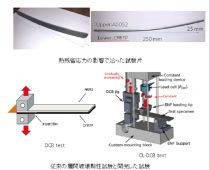Development of Test Method for Evaluating Pure Mode Interlaminar Fracture Toughness of Dissimilar Materials
2020-1124-02

- researcher's name
-
about researcher HOSOI, Atsushi Professor
- affiliation
-
Faculty of Science and Engineering School of Fundamental Science and Engineering
- research field
-
Materials/Mechanics of materials
- keyword
-
background
● Development of dissimilar joining technologies for multi-material automotive bodies and aircraft fuselages
● The Need for Accurate Mechanical Characterization of Fiber Reinforced Thermoplastics (FRTP) to Metal Joints
● The Need for Accurate Mechanical Characterization of Fiber Reinforced Thermoplastics (FRTP) to Metal Joints
summary
● Application of Double Cantilever Beam (DCB) test
● Cancel the effects of mixing modes when joining dissimilar materials and thermal residual stress
● Accurate mode I interlaminar fracture toughness evaluation
● Cancel the effects of mixing modes when joining dissimilar materials and thermal residual stress
● Accurate mode I interlaminar fracture toughness evaluation
predominance
● Easy evaluation by conventional DCB test method
● Evaluation considering the effect of thermal residual stresses
● Applicable to any dissimilar material bonding specimen
● Obtaining fracture toughness values for numerical simulations
● Evaluation considering the effect of thermal residual stresses
● Applicable to any dissimilar material bonding specimen
● Obtaining fracture toughness values for numerical simulations
application/development
● Design of machines and structures with dissimilar materials
● Improvement in the bonding strength of FRTP and metals
● Development of new composite materials.
● Improvement in the bonding strength of FRTP and metals
● Development of new composite materials.
same researcher's seeds
-
 Fabrication of carbon nanotube yarn with high functionality
Fabrication of carbon nanotube yarn with high functionality -
 Direct Bonding of Dissimilar Materials Having 3D Nanostructured Interfaces
Direct Bonding of Dissimilar Materials Having 3D Nanostructured Interfaces -
 Healing of Fatigue Crack in the Metallic Materials by Heat Treatment
Healing of Fatigue Crack in the Metallic Materials by Heat Treatment -
 Dissimilar Materials Bonding with 3D Nano Interface
Dissimilar Materials Bonding with 3D Nano Interface
posted:
2020/12/17



